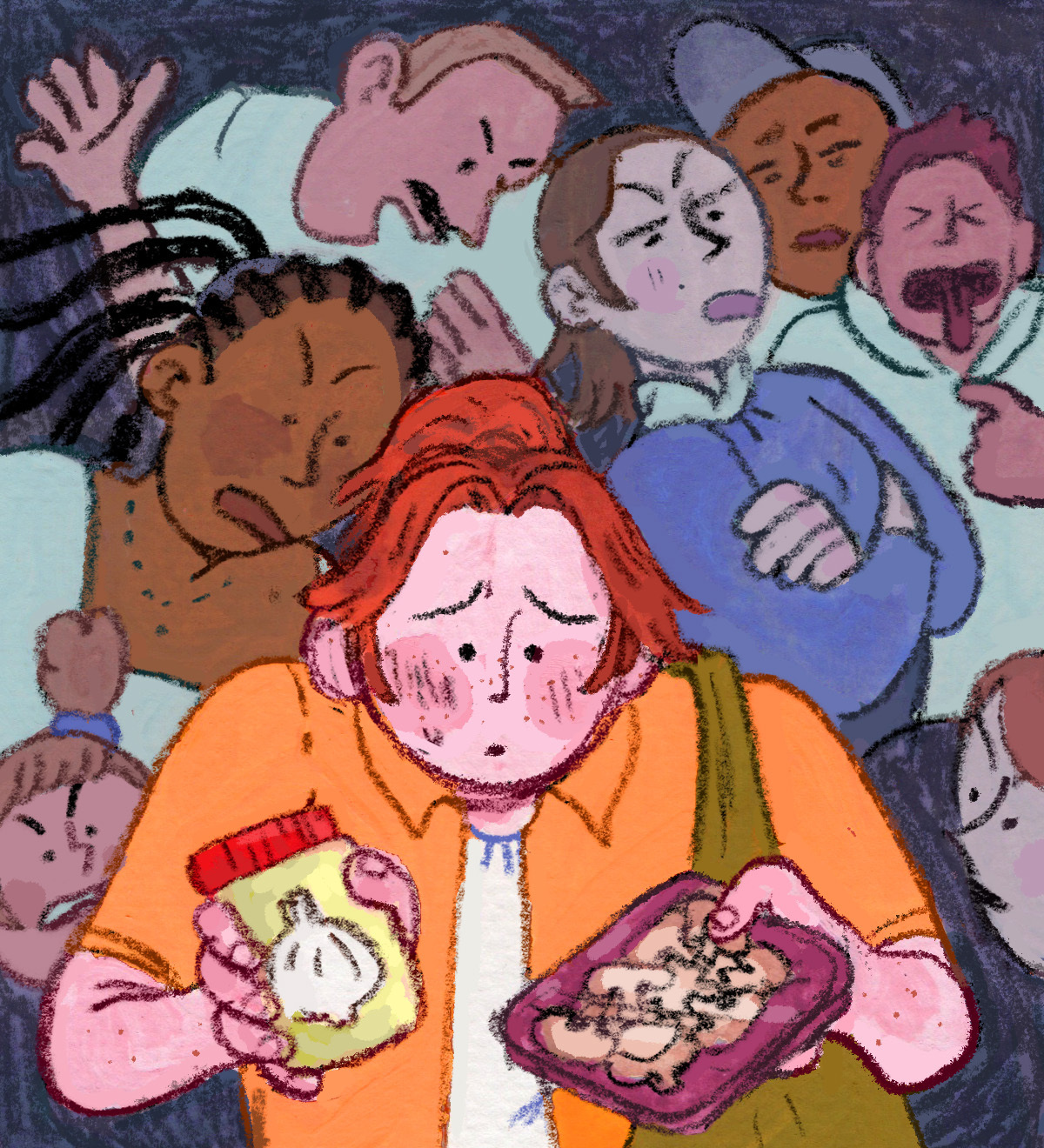I was in my second year of university when I discovered the joy of making meals from scratch. My desire to cook was sparked, partly, by the sheer excitement of having access to a kitchen. After a year of mostly eating the same few vegetarian meals from a dorm cafeteria, the possibilities now felt endless. Between classes, I rushed home and delighted in the ritual of trying a new technique or recipe: the perfect temperature at which to roast cauliflower, how to fry tofu so the edges were just crispy enough, how to use up all those cans of chickpeas I bought on sale.
My curiosity was further bolstered by the fact that I was coming into young adulthood around the same time that YouTube cooking channels were becoming part of pop culture; this was 2017, when Bon Appétit had just launched its now-famous Gourmet Makes series, and shows like Binging with Babish were garnering millions of views. As a terminally online student, I spent far too much of my time watching their videos and experimenting with their recipes.
One afternoon, I was making a stir-fry in the small kitchen of a house where I lived. As vegetables sputtered in hot oil on the stove, I remember one of my roommates coming downstairs and poking her head into the kitchen.
“What smells so good?” She smiled.
“Probably the garlic,” I answered, stirring the bright contents of the pan.
I recall her eyeing the mess I’d made on the counter—discarded pieces of carrot and onion, spices spilled from plastic bags—and stopping when she saw the little jar. A spoon lay beside it, still slick with preservative oil.
“You use the pre-minced stuff?”
“Yeah,” I said.
She wrinkled her nose and receded. I could tell I’d done something unsavoury.
I’d been in the habit of buying jarred garlic—the kind that comes minced and suspended in oil—because it was easy to use. I was still getting accustomed to the patience and time that cooking required, and the jarred stuff seemed like a no-brainer: a way to save a few minutes. But, after that day, I stopped buying it. I’m not sure I even finished that container—it likely sat half-empty in the fridge for the rest of the semester. As I started to pride myself on my cooking, I also became hyperaware of wanting to do things the right way, and I noticed all the recipes and cooking shows I followed only ever used fresh ingredients.
Online, people affirmed my new belief. They joked that those who use jarred garlic can’t cook. “What if you met your soul mate, but then found out they cook with pre-minced garlic in a jar,” one tweet said. Media outlets published article after article condemning the stuff. An old quote by the celebrity chef Anthony Bourdain seemed to resurface every few months. “Avoid at all costs that vile spew you see rotting in screwtop jars,” he had written in his book Kitchen Confidential, first published in 2000. “Too lazy to peel fresh? You don’t deserve to eat garlic.”
This was the first of many haughty ideas I’d hear about cooking and how selective we should be with our food. Who would buy a bottle of lemon juice when you could buy fresh lemons? Shredded cheese when you could grate your own? Pre-sliced mushrooms when they were apparently cheaper and better whole? An image of pre-peeled oranges from Whole Foods caused so much outrage in 2016 that the product was pulled from stores. Then there was the notion that those who opted for these packaged foods or ingredients weren’t just lazy—they were wreaking havoc on the environment with all that unnecessary plastic. Under all of this criticism, there was always a minority voice telling people they were being ableist. Those voices reminded us that disabled people rely on these shortcuts—that not everyone can chop and peel and slice. Over and over again, those voices were drowned out by the majority.
I, too, ignored them, and I learned to love fresh garlic. I learned to love the feeling of smashing a clove between a cutting board and the flat side of a knife. Of mincing it: always by hand, never with a press. I learned to always use more than the recipe called for, to love the smell and sizzle of it frying, to make sure it didn’t get all browned and bitter in the pan. I learned to appreciate the slight (but usually unnoticeable) difference in taste when I used the fresh stuff, the allicin edge a little sharper or more present.
Then, in early 2021, I developed a nerve problem that changed everything.
My life became immeasurably different last winter. A repetitive strain injury led me to develop thoracic outlet syndrome. Pain shot through my forearms and into my fingers when I did simple tasks. My hands often went numb. My elbows ached and seized. Looking down at anything—a book, a cutting board—hurt my neck and shoulders and worsened the rest of my symptoms.
As months went by, I got used to assistive technology, swapping a keyboard for voice-to-text. I asked for help when I needed to. I used paper plates, as I was unable to wash dishes myself. So many things tied to my identity were now inaccessible to me: hobbies such as embroidery and video games, writing with a pen, the Sunday-morning pastime of sitting hunched over a crossword puzzle, filling in and erasing answers. I felt I had lost so much. I didn’t want to lose being a good cook too. So I continued to only ever use fresh garlic.
On a good day, I would wince and tear up as I peeled each clove from its papery skin, as I crushed it on a cutting board, as I minced it into tiny pieces. On a bad day, my hands would be so numb and my fingers so swollen that I would be unable to even grip the handle of a knife tightly enough.
Even at such points, I never considered buying jarred garlic. I pushed through the pain, no matter how excruciating. And, on especially bad days, I omitted the ingredient altogether, my food missing a certain edge I’d grown to love.
Cooking shortcuts have been around for a long time, but for at least a century, we’ve been finding ways to appease those who turn their noses up at easier options. In 1929, molasses manufacturer P. Duff & Sons started selling dehydrated flour mix—made up of wheat flour, molasses, sugar, shortening, salt, baking soda, ginger, cinnamon, and powdered whole egg. Housewives simply had to add water to the mixture and bake it to produce a dessert. In the early 1930s, the company released a cake mix with a similar concept. But it later amended the product to have cooks add the eggs themselves, stating, “The housewife and the purchasing public in general seem to prefer fresh eggs.” Other food brands, such as Betty Crocker, followed suit.
The fresh eggs did make for a better-tasting dessert—the dried-egg mixtures produced cakes that stuck to the pan and often had a strong flavour of eggs—but the desire to add the ingredient yourself was at least partially psychological. Cracking and mixing in eggs provided the illusion of participation, and this became the first step in making a creation with layers and packaged frosting.
It seems the aesthetics of being a good cook by using fresh ingredients have always triumphed over convenience. But the disdain for shortcuts and anything that isn’t fresh feels especially pronounced today. This might be partially because of the wellness industry: as a love of whole foods and a fear of preservatives have become commonplace, people seem more comfortable announcing their disgust for anything processed or impure. Social media has made it easier for fresh-food purists, many with entire accounts devoted to “clean eating,” to make their opinions known too. Though not all of these accounts explicitly condemn processed foods, they perpetuate the idea that whole foods are significantly better.
The culture that surrounds cooking today is one that lends itself well to casual ableism. It’s a culture that prizes specific ways of doing things over others, constantly pitting methods and recipes against one another: French-style scrambled eggs over American; minced garlic instead of pressed, nonstick pans against those made of cast iron, bouillon cubes against broth cartons against homemade stock. It’s a culture desperate to identify serious cooks as opposed to casual ones, assigning value to almost everything we do in the kitchen. Did you stir that with a wooden spoon? Did you cook it in the right kind of oil? Did you use pre-ground pepper? Kosher salt or iodized? In a culture obsessed with the right and wrong way of doing things, any choice you make is likely controversial to some, eliciting either eye rolls or enthusiasm.
Often, the wrong choice is the easier (read: more accessible) one—and making it is a fatal flaw. These aren’t things to try to avoid when you can. They’re things you should never do, even though many of us don’t have a choice. This lack of nuance is what made me believe using accessibility tools might make me a bad cook, pushing me to hurt myself even when cooking alone.
None of this is intentional. People aren’t thinking about disabled cooks when they turn their noses up at pre-minced garlic or pre-ground pepper or whatever else. That’s part of the problem, though: dismissing ingredients and disparaging anyone who uses them means not thinking of who, exactly, that might be. In reality, it doesn’t take much critical thinking to get there.
Who needs to use a quicker, less-labour-intensive method in the kitchen? Maybe it’s someone short on time. Maybe it’s someone who can’t afford to keep topping up the fresh stuff before it goes bad. Maybe it’s someone with mobility issues or chronic pain, or it’s a neurodivergent person who struggles with long, multistep tasks. Maybe it’s someone who loves fresh garlic but is, for whatever reason, not able to chop it themselves.
Because of this, it’s hard to watch a chef’s YouTube video or read through a recipe without constantly being reminded that the food I make will never be good enough. Sometimes, it’s hard to believe you can be a good cook at all while being disabled.
As my condition worsened, I kept pushing myself physically—because who was I if not someone who could pride herself on her food? I kept laughing at jokes about the kind of person who used pre-minced garlic, not wanting to admit that that could be me. And I stopped enjoying spending time in the kitchen, as the pain I felt while I cooked lingered for hours or days afterwards. I avoided cooking as much as possible, often ordering in and eating frozen meals instead.
The more time went on, the more I came to understand disability and casual ableism. As I spoke to other disabled people who used accessibility tools such as electric jar openers or mandolin slicers in their own kitchens, I came to understand that these tools wouldn’t make me a bad cook: they would just allow me to enjoy cooking at all. As my symptoms became chronic, I learned to accept that being disabled meant navigating the world a little differently and that reaching for tools to make my life easier wasn’t a personal failing.
Eventually, I stocked my kitchen with all the things I simply needed: ground pepper, shredded cheese, a bright yellow bottle of lemon juice. Hesitant to leave fresh garlic behind, I bought pre-peeled cloves before eventually relenting, reaching for a little jar of the pre-minced stuff. And, as cooking became easier, it also became fun again.
There are days when the ableism in cooking still makes me feel alienated. Even as someone who talks openly and often about my struggles with the use of my hands, I face ableism from friends and colleagues who don’t know any better. Under a tweet where I simply said, “Pre-minced garlic is good, actually,” an acquaintance responded that Anthony Bourdain would be rolling in his grave. (The account has since been deleted.) Another posted a meme about how wrong I was. One person—a stranger—told me this opinion was the reason we should end our species altogether; pre-minced garlic is apparently the grounds for mass extinction.
Though I’d like to say that seeing the suggestion made under a lighthearted tweet didn’t bother me, I’m afraid to report it did.
I’m not here to argue that pre-minced garlic tastes the same as the fresh stuff (it doesn’t) nor that any of the alternatives I’ve mentioned are equivalent to their fresh counterparts. I’m here to say the way we talk about accessible food options—whether in our homes, in recipe books, or in cooking shows—needs to change.
The question of why someone might use pre-minced garlic is less important than this one: Does it matter?
Cooking should be about the joy of making something you’re excited to eat or serve—about preparing food you like in whatever way works best for you.
You can cook the way you want to. You can even say your way is better, if you like. But there’s no reason to say other ways are wrong or disgusting. The simple truth is that being a good cook isn’t exclusively about using “high-quality” ingredients. It’s about making great food with what’s available to you.
In my little kitchen, I toss pre-sliced mushrooms and pre-minced garlic in sizzling oil, filling my apartment with a rich allicin smell. And I feel comfortable in my skills, even if fresh garlic is absent from my pantry.




